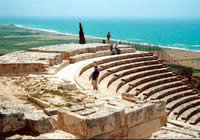|
|
| |
| |
| |
|
| |
 |
| |
|
| uses Google technology and indexes
only and selectively internet - libraries
having books with free public access |
|
 |
|
|
 |
|
| |
|
| |
Previous | |
Next |
|
 |
CLAUDE DELAVAL COBHAM
Exerpta Cypria
page 29 View PDF version of this page Of the Monastery of S. Dominic.
There is in this city a monastery of S. Dominic, in which is a fair vaulted church. There is α fair cloister with gardens, a dormitory and other buildings for the use of the monks, though most of them are in ruins. At present all the monks live in a shabby way in this city of Famagosta.
Of the villages of Famagosta.
Outside the city of Famagosta there were formerly large and populous villages— I reckon there were two thousand hearths—and in them many fair churches. But now the said villages are wholly destroyed, so that there is not one sound house, and not one person lives there. There are many seemly churches, among which is the church of S. Maria of the cave, very seemly, and many people, Latins, and Greeks, go to the said church to pray.
Of the building of the city of Famagosta.
One part of this city of Famagosta is close to the sea, and another larger part is away from the sea: it is encompassed with very fine ditches built throughout. The whole city, or at least its walls, are based on stone as hard as marble, so that it cannot possibly be hewn out: and in the city on the seaside is an arsenal, large and fine like that of Naples. Formerly, that is a hundred years ago, the city was set elsewhere, and stood where is a place named Constanza, four miles from Famagosta, The city was then called Constanza from a king Constantius, father of the blessed Catherine, who built it. It was two miles from the sea, and had no harbour. And when Acre was lost, which was the last place in Syria lost by the Christiaus, all the people who escaped from Acre fled to the island of Cyprus, and then that ancient city- Constanza was removed to the place where is now Famagosta.
Of the women's dress.
And hence comes a custom that all women, as well of that town of Famagosta as of the other towns of the island, wear black mantles on their heads so that their faces cau hardly be seen. And this custom began and has been followed on account of the sorrow and dire grief for the loss of that city of Acre and other cities of Syria, and the greater part of the city of Famagosta was made up of the people of Acre.
Of the bad air.
Between the city of Famagosta and the ancient city of Constantia is a large marsh, which seems like an aim of the sea. And it is held that on account of that marsh, and the great number of courtesans, a had air affects the men who dwell in that city.
Of the place tchere S. Catherine teas horn. And because through the grace of our Lord Jesus Christ Who permitted me to do so I saw all the story of the blessed Catherine, and all that she did, as well in Alexandria, the place of her prison and the glorious martyrdom which she endured in honour of our Lord Jesus Christ on the wheel between those two columns, as in her church, where her glorious body was placed by the holy angels on the summit of that great mountain, and then her holy body which was translated from that lofty mountain to her own church of S. Catherine, I desimi also to see the place of her nativity; wherefore on the fifth day of December of the third indiction I went to that ancient city Constantia four miles distant from Famagosta,
24
EXCERPTA CYPRIA.
View PDF version of this page
|
 |
| |
Previous |
First |
Next |
|
|
|